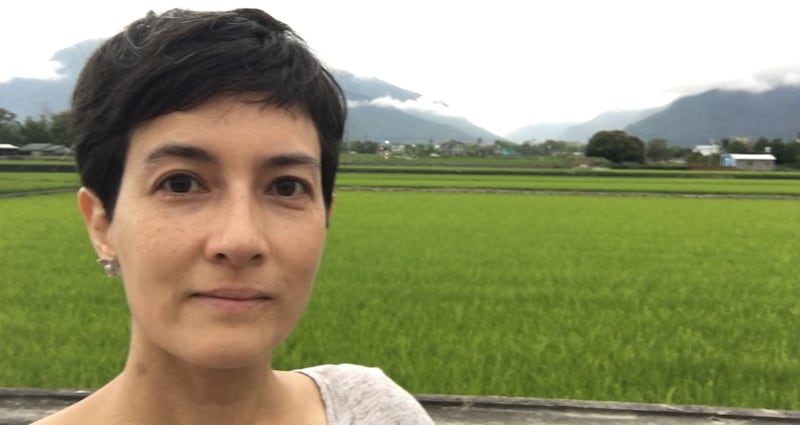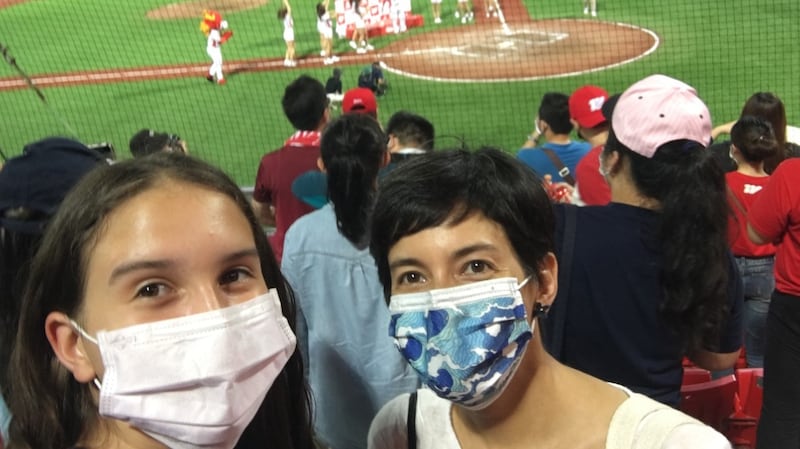Tara Duffy was born in the United States to Irish and Chinese parents; she moved to Kinvara, Co Galway, with her partner, J, and daughter, Moy, in 2013.
In March 2020, shortly after Ireland went into its first lockdown, my partner, 11-year-old daughter and I spent the night in rented sleeping bags in an unheated mountain lodge at an altitude of 3,400m while the outside temperature dipped to 3 degrees.
After a restless sleep, interrupted by the intermittent coughing of strangers in our shared room of 20-plus bunks, we heard others rouse at 3 am to set off for the last push to reach the main peak of Yushan, also known as Mount Jade, Taiwan’s tallest mountain, in time for the sunrise.
Alone at the peak of Yushan, surrounded by distant blue mountain ridges, looking down on to the waves of clouds, I felt a surge of gratitude for being able to experience the moment in solitude and to breathe pristine air
We had decided to forgo a predawn climb and instead set off midmorning. We were only 20 minutes in when our daughter, Moy, complained she was short of breath and her head hurt. The Covid-like symptoms worried us. We tried to decipher whether it was preteen resistance to a second day of climbing or mild altitude sickness.
Her father, who had already bolted over to the west peak for the sunrise, returned to join us. He volunteered to take her back to the lodge, where a nap and some noodles seemed to fix everything. I carried on, passing sunrise stragglers on their way down, and ended up the only one still scaling the final 120m ascent at 1pm. Alone at the peak, surrounded by distant blue mountain ridges, looking down on to the waves of clouds, I felt a surge of gratitude for being able to experience the moment in solitude and to breathe pristine air.
Just a few months earlier we had packed a couple suitcases for a "year out" from Galway and arrived in Taiwan's capital, Taipei. Looking back, climbing the highest mountain around as the virus raged in Wuhan and had started to spread across the world was a bit crazy. Wuhan is less than 1,000km from Taipei, closer than Galway is to Bilbao.
We were perhaps naively confident at the time of Taiwan's ability to contain what by then was around 200 cases on the island. But our initial gut instinct on how the government was able to handle the virus, thankfully, proved to be right. Cases in Taiwan from January 2020 to May 2021 totalled about 1,000, with 12 deaths. Managing Covid-19 was no small feat for the island of 23 million people, geographically and economically so close to mainland China.

Back in 2019, our decision to head to Taipei was based on a convergence of work opportunities and the chance to spend time in a Chinese-speaking city before our daughter started secondary school. From 2004 to 2013 I worked first as a journalist and then for an NGO in Beijing, where Moy was born. She grew up bilingual in English and Chinese. However, after we moved to my partner’s mother’s hometown of Kinvara, in 2013, her Chinese began to fade.
Little did we know just how fortuitous our choice would be. For the first 16 months of the pandemic Taiwan was one of the few places in the world considered successful in containing Covid-19. Before May 2021 there was no lockdown, and daily life went on more or less as usual – with masks on, of course.
Bar a couple of weeks when schools went online, in the spring of 2020, my daughter had the privilege of going to school in-person. We even went to see Feet of Flames at an indoor stadium in December.
In February, as Ireland was in its post-Christmas lockdown, we felt almost guilty to be able to travel along the isolated and beautiful east coast of Taiwan, learning about the intersection of the island’s indigenous people, Japanese colonial history, and local communities.
My partner, J, who previously went on business trips every couple of weeks, worked from home from February 2020. As it was for so many, WFH was a huge adjustment, especially considering the eight-hour time difference with colleagues in Europe, which meant his day started just a couple of hours before Moy came home from school. Yet he made time to explore Taiwan’s mountains. Parts of the coast could easily be mistaken for west Cork, Clare or Galway. J even joined the Taiwan Celts GAA, the oldest club in Asia.
Coronavirus virus hit greater Taipei, one of the world's most densely populated places, in ways starkly reminiscent of the beginning of the pandemic in Ireland, spreading in care homes and taking the elderly and vulnerable
All of this was possible solely due to Taiwan’s early action. By the time we were climbing Mount Jade, in March 2020, Taiwan had already closed its borders to nonresidents and implemented a mandatory 14-day quarantine first for those coming from mainland China, later extending it to the rest of the world.
Eating was banned on trains, and masks were required for the entire journey, from the moment you entered a station. Conductors would politely remind passengers to keep the masks properly on. Stations, hotels, restaurants and even small shops had contactless temperature checks and hand-sanitiser dispensers that staff ensured were used on entry.
More restrictions came into effect following an outbreak in late April among international air crew and a quarantine hotel that was spread out and quickly infected 15,000 people, killing several hundred people. Vaccines were slow coming, for political and commercial reasons. As a result, the virus hit greater Taipei, one of the world’s most densely populated places, in ways starkly reminiscent of the beginning of the pandemic in Ireland, spreading in care homes and taking the elderly and vulnerable.
Our life swiftly shifted gears. Just before the outbreak in Taipei, J had gone back to see his mother. On his visits to see her, he brought Moy and me online to see her grandmother, who passed away peacefully just a few weeks later. Moy’s school finished the last three weeks online. In late May my job teaching Iyengar yoga moved online for the first time.

I was fortunate to have had one dose of the vaccine back in early May. At the time many Taiwanese still were wary of the AstraZeneca vaccine, the only jab available. Despite there being only a few hundred thousand doses in thecountry, the government introduced a programme to use the vaccines before their expiry date and allowed those who needed to travel abroad to pay for their vaccination. That programme quickly ended amid the outbreak in May.
At different points of the Covid case trajectory, the differences between Ireland and Taiwan were striking. As Ireland opened up in June, with several hundred cases a day, Taiwan shut down with nearly the same number of daily cases. In some ways, we then experienced a little of what the rest of the world had been through. In late June our time in Taiwan was up. We boarded a flight to London, the first step to return to Galway.
After quarantine it felt odd to be out and about in a city with more cases in the previous two weeks than in all of Taiwan for the entire outbreak. Seeing family and friends again, the sun setting over the Burren, and shooting stars in the August sky over Kinvara has been the best homecoming possible. At the same time we are starkly aware of the hardships the country has faced while we were abroad. We were saddened to leave Taiwan, which kept us safe, healthy, in school and in employment and kept us more than entertained throughout the pandemic. Leaving as Taiwan fought the virus was even more poignant. It feels not only a joy but also a privilege to finally be back home.
If you live overseas and would like to share your experience with Irish Times Abroad, email abroad@irishtimes.com with a little information about you and what you do











